Mutual Causality Between Urban Transport Superiority Degree and Urban Land Use Efficiency: Insights from County Cities in Gansu Province Under the Belt and Road Initiative
Abstract
:1. Introduction
2. Materials and Methods
2.1. Study Area
2.2. Data Sources
2.3. Research Methods
2.3.1. Construction of the UTSD Model
2.3.2. ULUE Evaluation Model and Indicators Selection
2.3.3. Coupling Coordination Degree Model (CCDM)
2.3.4. Moran Index and LISA Agglomeration
2.3.5. Panel Granger Causality Test (PGCT)
2.3.6. Random Forest (RF)
2.3.7. Mixed Geographically and Temporally Weighted Regression (MGTWR) Model
3. Results
3.1. Spatiotemporal Variation of UTSD and ULUE
3.1.1. Spatiotemporal Variation of UTSD
3.1.2. Spatiotemporal Variation of ULUE
3.2. Spatiotemporal Relationship Between UTSD and ULUE
3.2.1. Coupled Relationship and Evolution of UTSD and ULUE
3.2.2. Spatial Agglomeration Changes in UTSD and ULUE
3.3. Interactive Relationship Between UTSD and ULUE
3.3.1. Panel Granger Causality Hypothesis Test of UTSD and ULUE
3.3.2. Measure the Contribution of UTSD and ULUE Interactions
3.3.3. Spatial Heterogeneity of UTSD and ULUE Interactions
4. Discussion
4.1. Spatiotemporal Pattern Evolution of UTSD and ULUE
4.2. Coupling Relationship Between UTSD and ULUE
4.3. Interaction Mechanisms of UTSD and ULUE
4.4. Policy Recommendations and Shortcomings of This Study
4.4.1. Policy Recommendations
4.4.2. Deficiency and Prospect
5. Conclusions
Author Contributions
Funding
Data Availability Statement
Acknowledgments
Conflicts of Interest
References
- Mahmoudi, R.; Shetab-Boushehri, S.-N.; Hejazi, S.R.; Emrouznejad, A. Determining the relative importance of sustainability evaluation criteria of urban transportation network. Sustain. Cities Soc. 2019, 47, 101493. [Google Scholar] [CrossRef]
- Blaydes, L.; Paik, C. Trade and Political Fragmentation on the Silk Roads: The Economic Effects of Historical Exchange between China and the Muslim East. Am. J. Political Sci. 2021, 65, 115–132. [Google Scholar] [CrossRef]
- Rodrigue, J.-P.; Comtois, C.; Slack, B. The Geography of Transport Systems, 3rd ed.; Routledge: London, UK, 2013. [Google Scholar]
- Kasraian, D.; Maat, K.; Stead, D.; Van Wee, B. Long-term impacts of transport infrastructure networks on land-use change: An international review of empirical studies. Transp. Rev. 2016, 36, 772–792. [Google Scholar] [CrossRef]
- Jin, F.; Wang, C.; Li, X. Discrimination method and its application analysis of regional transport superiority. Acta Geogr. Sin. 2008, 63, 787–798. [Google Scholar] [CrossRef]
- Jin, F.; Wang, C.; Li, X.; Wang, J. China’s regional transport dominance: Density, proximity, and accessibility. J. Geogr. Sci. 2010, 20, 295–309. [Google Scholar] [CrossRef]
- Zheng, S.; Dai, H.; Wang, G.; Miao, L.; Zhang, W. Application of Transportation Superiority in Beijing-Tianjin-Hebei Region Based on High-Resolution Satellite Remote Sensing Data. In Proceedings of the 2021 IEEE International Geoscience and Remote Sensing Symposium IGARSS, Brussels, Belgium, 11–16 July 2021; pp. 6964–6967. [Google Scholar] [CrossRef]
- Zhu, X.; Zhang, P.; Wei, Y.; Li, Y.; Zhao, H. Measuring the efficiency and driving factors of urban land use based on the DEA method and the PLS-SEM model—A case study of 35 large and medium-sized cities in China. Sustain. Cities Soc. 2019, 50, 101646. [Google Scholar] [CrossRef]
- Estoque, R.C.; Ooba, M.; Togawa, T.; Hijioka, Y.; Murayama, Y. Monitoring global land-use efficiency in the context of the UN 2030 Agenda for Sustainable Development. Habitat Int. 2021, 115, 102403. [Google Scholar] [CrossRef]
- Xue, D.; Yue, L.; Ahmad, F.; Draz, M.U.; Chandio, A.A.; Ahmad, M.; Amin, W. Empirical investigation of urban land use efficiency and influencing factors of the Yellow River basin Chinese cities. Land Use Policy 2022, 117, 106117. [Google Scholar] [CrossRef]
- Jiao, L.; Xu, Z.; Xu, G.; Zhao, R.; Liu, J.; Wang, W. Assessment of urban land use efficiency in China: A perspective of scaling law. Habitat Int. 2020, 99, 102172. [Google Scholar] [CrossRef]
- Liu, J.; Hou, X.; Wang, Z.; Shen, Y. Study the effect of industrial structure optimization on urban land-use efficiency in China. Land Use Policy 2021, 105, 105390. [Google Scholar] [CrossRef]
- He, S.; Yu, S.; Li, G.; Zhang, J. Exploring the influence of urban form on land-use efficiency from a spatiotemporal heterogeneity perspective: Evidence from 336 Chinese cities. Land Use Policy 2020, 95, 104576. [Google Scholar] [CrossRef]
- Dong, Y.; Jin, G.; Deng, X. Dynamic interactive effects of urban land-use efficiency, industrial transformation, and carbon emissions. J. Clean. Prod. 2020, 270, 122547. [Google Scholar] [CrossRef]
- Liu, S.; Xiao, W.; Li, L.; Ye, Y.; Song, X. Urban land use efficiency and improvement potential in China: A stochastic frontier analysis. Land Use Policy 2020, 99, 105046. [Google Scholar] [CrossRef]
- Yu, J.; Zhou, K.; Yang, S. Land use efficiency and influencing factors of urban agglomerations in China. Land Use Policy 2019, 88, 104143. [Google Scholar] [CrossRef]
- Wu, Q.; Cao, Y.; Fang, X.; Wang, J.; Li, G. A systematic coupling analysis framework and multi-stage interaction mechanism between urban land use efficiency and ecological carrying capacity. Sci. Total Environ. 2022, 853, 158444. [Google Scholar] [CrossRef]
- Kuang, B.; Lu, X.; Zhou, M.; Chen, D. Provincial cultivated land use efficiency in China: Empirical analysis based on the SBM-DEA model with carbon emissions considered. Technol. Forecast. Soc. Change 2020, 151, 119874. [Google Scholar] [CrossRef]
- Pradhan, R.P.; Arvin, M.B.; Nair, M. Urbanization, transportation infrastructure, ICT, and economic growth: A temporal causal analysis. Cities 2021, 115, 103213. [Google Scholar] [CrossRef]
- Banerjee, A.; Duflo, E.; Qian, N. On the road: Access to transportation infrastructure and economic growth in China. J. Dev. Econ. 2020, 145, 102442. [Google Scholar] [CrossRef]
- Lu, X.; Wang, M.; Tang, Y. The Spatial Changes of Transportation Infrastructure and Its Threshold Effects on Urban Land Use Efficiency: Evidence from China. Land 2021, 10, 346. [Google Scholar] [CrossRef]
- Zhao, G.; Zheng, X.; Yuan, Z.; Zhang, L. Spatial and Temporal Characteristics of Road Networks and Urban Expansion. Land 2017, 6, 30. [Google Scholar] [CrossRef]
- Liu, Z.; Zeng, S.; Jin, Z.; Shi, J.J. Transport infrastructure and industrial agglomeration: Evidence from manufacturing industries in China. Transp. Policy 2022, 121, 100–112. [Google Scholar] [CrossRef]
- Jiao, J.; Wang, J.; Zhang, F.; Jin, F.; Liu, W. Roles of accessibility, connectivity and spatial interdependence in realizing the economic impact of high-speed rail: Evidence from China. Transp. Policy 2020, 91, 1–15. [Google Scholar] [CrossRef]
- Long, F.; Zheng, L.; Song, Z. High-speed rail and urban expansion: An empirical study using a time series of nighttime light satellite data in China. J. Transp. Geogr. 2018, 72, 106–118. [Google Scholar] [CrossRef]
- Qiao, W.; Huang, X. Change in Urban Land Use Efficiency in China: Does the High-Speed Rail Make a Difference? Int. J. Environ. Res. Public Health 2021, 18, 10043. [Google Scholar] [CrossRef] [PubMed]
- Cui, X.; Fang, C.; Wang, Z.; Bao, C. Spatial relationship of high-speed transportation construction and land-use efficiency and its mechanism: Case study of Shandong Peninsula urban agglomeration. J. Geogr. Sci. 2019, 29, 549–562. [Google Scholar] [CrossRef]
- Wang, D.; Gong, Z.; Yang, Z. Design of industrial clusters and optimization of land use in an airport economic zone. Land Use Policy 2018, 77, 288–297. [Google Scholar] [CrossRef]
- Gingerich, K.; Maoh, H. The role of airport proximity on warehouse location and associated truck trips: Evidence from Toronto, Ontario. J. Transp. Geogr. 2019, 74, 97–109. [Google Scholar] [CrossRef]
- Kamruzzaman, M.; Aston, L.; Baker, D.; Braun, B.; Shatu, F. Changes in land use typology of global airports: An empirical investigation with implications for the aerotropolis concept. J. Transp. Geogr. 2021, 97, 103217. [Google Scholar] [CrossRef]
- Mothorpe, C.; Hanson, A.; Schnier, K. The impact of interstate highways on land use conversion. Ann. Reg. Sci. 2013, 51, 833–870. [Google Scholar] [CrossRef]
- Gonzalez-Navarro, M.; Turner, M.A. Subways and urban growth: Evidence from earth. J. Urban Econ. 2018, 108, 85–106. [Google Scholar] [CrossRef]
- Condeço-Melhorado, A.; Tillema, T.; De Jong, T.; Koopal, R. Distributive effects of new highway infrastructure in the Netherlands: The role of network effects and spatial spillovers. J. Transp. Geogr. 2014, 34, 96–105. [Google Scholar] [CrossRef]
- Zhai, M.; Wolff, H. Air pollution and urban road transport: Evidence from the world’s largest low-emission zone in London. Environ. Econ. Policy Stud. 2021, 23, 721–748. [Google Scholar] [CrossRef]
- Wang, X.; Duan, Z.; Wu, L.; Yang, D. Estimation of carbon dioxide emission in highway construction: A case study in southwest region of China. J. Clean. Prod. 2015, 103, 705–714. [Google Scholar] [CrossRef]
- Maparu, T.S.; Mazumder, T.N. Transport infrastructure, economic development and urbanization in India (1990–2011): Is there any causal relationship? Transp. Res. Part A Policy Pract. 2017, 100, 319–336. [Google Scholar] [CrossRef]
- Cao, S.; Xu, H.; Xu, Y.; Wang, X.; Zheng, Y.; Li, Y. Assessment of the integrated benefits of highway infrastructure and analysis of the spatiotemporal variation: Evidence from 29 provinces in China. Socio-Econ. Plan. Sci. 2023, 90, 101740. [Google Scholar] [CrossRef]
- Ren, Y.; Tian, Y.; Xiao, X. Spatial effects of transportation infrastructure on the development of urban agglomeration integration: Evidence from the Yangtze River Economic Belt. J. Transp. Geogr. 2022, 104, 103431. [Google Scholar] [CrossRef]
- Zhao, S.; Yan, Y.; Han, J. Industrial Land Change in Chinese Silk Road Cities and Its Influence on Environments. Land 2021, 10, 806. [Google Scholar] [CrossRef]
- Mayer, M.; Zhang, X. Theorizing China-world integration: Sociospatial reconfigurations and the modern silk roads. Rev. Int. Political Econ. 2021, 28, 974–1003. [Google Scholar] [CrossRef]
- Jiang, H. Spatial–temporal differences of industrial land use efficiency and its influencing factors for China’s central region: Analyzed by SBM model. Environ. Technol. Innov. 2021, 22, 101489. [Google Scholar] [CrossRef]
- Xiao, Y.; Zhong, J.-L.; Zhang, Q.-F.; Xiang, X.; Huang, H. Exploring the coupling coordination and key factors between urbanization and land use efficiency in ecologically sensitive areas: A case study of the Loess Plateau, China. Sustain. Cities Soc. 2022, 86, 104148. [Google Scholar] [CrossRef]
- Liu, H.; Cui, W.; Zhang, M. Exploring the causal relationship between urbanization and air pollution: Evidence from China. Sustain. Cities Soc. 2022, 80, 103783. [Google Scholar] [CrossRef]
- Zhou, L.; Wu, T.; Pu, L.; Meadows, M.; Jiang, G.; Zhang, J.; Xie, X. Spatially heterogeneous relationships of PM2.5 concentrations with natural and land use factors in the Niger River Watershed, West Africa. J. Clean. Prod. 2023, 394, 136406. [Google Scholar] [CrossRef]
- Wang, Y.; Niu, Y.; Li, M.; Yu, Q.; Chen, W. Spatial structure and carbon emission of urban agglomerations: Spatiotemporal characteristics and driving forces. Sustain. Cities Soc. 2022, 78, 103600. [Google Scholar] [CrossRef]
- Guo, Z.; Xie, Y.; Guo, H.; Zhang, X.; Wang, H.; Bie, Q.; Xi, G.; Ma, C. Do the ecosystems of Gansu Province in Western China’s crucial ecological security barrier remain vulnerable? Evidence from remote sensing based on geospatial analysis. J. Clean. Prod. 2023, 402, 136740. [Google Scholar] [CrossRef]
- Yin, Z.; Feng, Q.; Zhu, R.; Wang, L.; Chen, Z.; Fang, C.; Lu, R. Analysis and prediction of the impact of land use/cover change on ecosystem services value in Gansu province, China. Ecol. Indic. 2023, 154, 110868. [Google Scholar] [CrossRef]
- Chen, W.; Bian, J.; Liang, J.; Pan, S.; Zeng, Y. Traffic accessibility and the coupling degree of ecosystem services supply and demand in the middle reaches of the Yangtze River urban agglomeration, China. J. Geogr. Sci. 2022, 32, 1471–1492. [Google Scholar] [CrossRef]
- Li, Y. Regional environmental efficiency in China: An empirical analysis based on entropy weight method and non-parametric models. J. Clean. Prod. 2020, 276, 124147. [Google Scholar] [CrossRef]
- Hu, H.; Wang, J.; Jin, F.; Ding, N. Evolution of regional transport dominance in China 1910–2012. J. Geogr. Sci. 2015, 25, 723–738. [Google Scholar] [CrossRef]
- Weiss, D.J.; Nelson, A.; Gibson, H.S.; Temperley, W.; Peedell, S.; Lieber, A.; Hancher, M.; Poyart, E.; Belchior, S.; Fullman, N.; et al. A global map of travel time to cities to assess inequalities in accessibility in 2015. Nature 2018, 553, 333–336. [Google Scholar] [CrossRef]
- Qin, X.; Qian, Y.; Zeng, J.; Wei, X. Accessibility and Economic Connections between Cities of the New Western Land–Sea Corridor in China—Enlightenments to the Passageway Strategy of Gansu Province. Sustainability 2022, 14, 4445. [Google Scholar] [CrossRef]
- Li, C.; Gao, X.; He, B.-J.; Wu, J.; Wu, K. Coupling Coordination Relationships between Urban-industrial Land Use Efficiency and Accessibility of Highway Networks: Evidence from Beijing-Tianjin-Hebei Urban Agglomeration, China. Sustainability 2019, 11, 1446. [Google Scholar] [CrossRef]
- Yang, Y.; Hu, N. The spatial and temporal evolution of coordinated ecological and socioeconomic development in the provinces along the Silk Road Economic Belt in China. Sustain. Cities Soc. 2019, 47, 101466. [Google Scholar] [CrossRef]
- Wood, S.N. A simple test for random effects in regression models. Biometrika 2013, 100, 1005–1010. [Google Scholar] [CrossRef]
- Li, J.; Li, G.; Liang, Y.; Yuan, J.; Xu, G.; Yang, C. Spatiotemporal differentiation of the ecosystem service value and its coupling relationship with urbanization: A case study of the Lanzhou-Xining urban agglomeration. Ecol. Indic. 2024, 160, 111932. [Google Scholar] [CrossRef]
- Liu, N.; Zou, B.; Li, S.; Zhang, H.; Qin, K. Prediction of PM2.5 concentrations at unsampled points using multiscale geographically and temporally weighted regression. Environ. Pollut. 2021, 284, 117116. [Google Scholar] [CrossRef]
- Xiao, F.; Wang, J.; Xiong, M.; Mo, H. Does spatiotemporal heterogeneity matter? Air transport and the rise of high-tech industry in China. Appl. Geogr. 2024, 162, 103148. [Google Scholar] [CrossRef]
- Zhang, X.; Liu, C.A. Model averaging prediction by K-fold cross-validation. J. Econom. 2023, 235, 280–301. [Google Scholar] [CrossRef]
- Jin, F.; Chen, Z. Evolution of transportation in China since reform and opening up: Patterns and principles. J. Geogr. Sci. 2019, 29, 1731–1757. [Google Scholar] [CrossRef]
- Leng, A.; Wang, K.; Bai, J.; Gu, N.; Feng, R. Analyzing sustainable development in Chinese cities: A focus on land use efficiency in production-living-ecological aspects. J. Clean. Prod. 2024, 448, 141461. [Google Scholar] [CrossRef]
- Wang, W.; Hu, Y.; Wang, J.; Niu, S. Urban construction land allocation efficiency of urban agglomerations in China based on a stochastic frontier production function approach. J. Clean. Prod. 2024, 434, 139965. [Google Scholar] [CrossRef]
- Jiang, Y.; Liu, X.; Yang, L.; Hu, T.; Pan, H.; Luo, H.; Han, W.; Xiao, S. Moving towards sustainable development in China’s rural counties: Ecological efficiency evaluation based on DEA-Malmquist-Tobit model. J. Clean. Prod. 2024, 442, 141093. [Google Scholar] [CrossRef]
- Lan, Z.; Zhi-bin, Z.; Ya-xiong, M.; Jiang-hong, D. Spatio-temporal dynamic evaluation of land use benefit and its coupling coordination in Gansu Province. IOP Conf. Ser. Earth Environ. Sci. 2020, 619, 012013. [Google Scholar] [CrossRef]
- Ma, L.; Chen, M.; Fang, F.; Che, X. Research on the spatiotemporal variation of rural-urban transformation and its driving mechanisms in underdeveloped regions: Gansu Province in western China as an example. Sustain. Cities Soc. 2019, 50, 101675. [Google Scholar] [CrossRef]
- Fan, X.; Qiu, S.; Sun, Y. Land finance dependence and urban land marketization in China: The perspective of strategic choice of local governments on land transfer. Land Use Policy 2020, 99, 105023. [Google Scholar] [CrossRef]
- Wu, H.; Fang, S.; Zhang, C.; Hu, S.; Nan, D.; Yang, Y. Exploring the impact of urban form on urban land use efficiency under low-carbon emission constraints: A case study in China’s Yellow River Basin. J. Environ. Manag. 2022, 311, 114866. [Google Scholar] [CrossRef]
- Ma, Y.; Zhang, P.; Zhao, K.; Zhou, Y.; Zhao, S. A Dynamic Performance and Differentiation Management Policy for Urban Construction Land Use Change in Gansu, China. Land 2022, 11, 942. [Google Scholar] [CrossRef]
- Wang, J.; Liu, H.; Liu, P.; Chang, G. An evaluation of the spatial rationality of provincial territory: A case study of Gansu Province. Environ. Sci. Pollut. Res. 2022, 30, 18268–18284. [Google Scholar] [CrossRef]
- Guo, X.; Chen, Y.; Jia, Z.; Li, Y.; Zhang, L.; Qiao, Z.; Hao, Y. Spatial and temporal inequity of urban land use efficiency in China: A perspective of dynamic expansion. Environ. Impact Assess. Rev. 2024, 104, 107357. [Google Scholar] [CrossRef]
- Zhang, P.; Li, W.; Zhao, K.; Zhao, S. Spatial Pattern and Driving Mechanism of Urban–Rural Income Gap in Gansu Province of China. Land 2021, 10, 1002. [Google Scholar] [CrossRef]
- Sun, Y.J.; Qiao, W.X.; Zhang, Y.S.; Yang, Y. GIS-Based Urban Land Use and Traffic Coordination Evaluation System. Appl. Mech. Mater. 2015, 738–739, 204–208. [Google Scholar] [CrossRef]
- Lu, X.; Shi, Z.; Li, J.; Dong, J.; Song, M.; Hou, J. Research on the Impact of Factor Flow on Urban Land Use Efficiency from the Perspective of Urbanization. Land 2022, 11, 389. [Google Scholar] [CrossRef]
- Jia, S.; Zhou, C.; Qin, C. No difference in effect of high-speed rail on regional economic growth based on match effect perspective? Transp. Res. Part A Policy Pract. 2017, 106, 144–157. [Google Scholar] [CrossRef]
- Wang, F.; Liu, Z.; Xue, P.; Dang, A. High-speed railway development and its impact on urban economy and population: A case study of nine provinces along the Yellow River, China. Sustain. Cities Soc. 2022, 87, 104172. [Google Scholar] [CrossRef]
- Wolff, M. Understanding the role of centralization processes for cities—Evidence from a spatial perspective of urban Europe 1990–2010. Cities 2018, 75, 20–29. [Google Scholar] [CrossRef]
- Paiho, S.; Mäki, E.; Wessberg, N.; Paavola, M.; Tuominen, P.; Antikainen, M.; Heikkilä, J.; Rozado, C.A.; Jung, N. Towards circular cities—Conceptualizing core aspects. Sustain. Cities Soc. 2020, 59, 102143. [Google Scholar] [CrossRef]
- Wang, Z.; Han, Q.; De Vries, B. Land Use/Land Cover and Accessibility: Implications of the Correlations for Land Use and Transport Planning. Appl. Spat. Anal. Policy 2019, 12, 923–940. [Google Scholar] [CrossRef]
- Langer, S.; Korzhenevych, A. The effect of industrial and commercial land consumption on municipal tax revenue: Evidence from Bavaria. Land Use Policy 2018, 77, 279–287. [Google Scholar] [CrossRef]
- Liu, L.; Zhang, M. High-speed rail impacts on travel times, accessibility, and economic productivity: A benchmarking analysis in city-cluster regions of China. J. Transp. Geogr. 2018, 73, 25–40. [Google Scholar] [CrossRef]
- Hu, W.; Shu, X.; Huang, B. Sustainability innovations in transportation infrastructure: An overview of the special volume on sustainable road paving. J. Clean. Prod. 2019, 235, 369–377. [Google Scholar] [CrossRef]
- Zandiatashbar, A.; Hamidi, S.; Foster, N. High-tech business location, transportation accessibility, and implications for sustainability: Evaluating the differences between high-tech specializations using empirical evidence from U.S. booming regions. Sustain. Cities Soc. 2019, 50, 101648. [Google Scholar] [CrossRef]
- Dawson, P. Establishing a high tech company in a global competitive market: A sociomaterial process perspective. Ind. Mark. Manag. 2020, 86, 233–243. [Google Scholar] [CrossRef]
- Luo, H.; Qian, Y.; Zeng, J.; Wei, X.; Guang, X. An Empirical Analysis of Logistics Corridors and Regional Economic Spatial Patterns from the Perspective of Compressive Transportation between Urban Agglomerations. Land 2022, 11, 726. [Google Scholar] [CrossRef]
- Yu, B.; Zhou, X. Urban administrative hierarchy and urban land use efficiency: Evidence from Chinese cities. Int. Rev. Econ. Financ. 2023, 88, 178–195. [Google Scholar] [CrossRef]
- Sarri, P.; Tzouras, P.G.; Tsigdinos, S.; Kaparias, I.; Kepaptsoglou, K. Incorporating Land Use and Transport Interaction Models to Evaluate Active Mobility Measures and Interventions in Urban Areas: A case study in Southampton, UK. Sustain. Cities Soc. 2024, 105, 105330. [Google Scholar] [CrossRef]
- Yin, J.; Li, S.; Zhou, L.; Jiang, L.; Ma, W. Spatial heterogeneity of the economic growth pattern and influencing factors in formerly destitute areas of China. J. Geogr. Sci. 2022, 32, 829–852. [Google Scholar] [CrossRef]
- Ma, L.; Chen, M.; Che, X.; Fang, F. Research on Population-Land-Industry Relationship Pattern in Underdeveloped Regions: Gansu Province of Western China as an Example. Sustainability 2019, 11, 2434. [Google Scholar] [CrossRef]
- Feyrer, J. Trade and Income—Exploiting Time Series in Geography. Am. Econ. J. Appl. Econ. 2019, 11, 1–35. [Google Scholar] [CrossRef]
- Bates, J.; Lin, Y.-W.; Goodale, P. Data journeys: Capturing the socio-material constitution of data objects and flows. Big Data Soc. 2016, 3, 205395171665450. [Google Scholar] [CrossRef]
- Li, X.; Fu, J.; Jiang, D.; Lin, G.; Cao, C. Land use optimization in Ningbo City with a coupled GA and PLUS model. J. Clean. Prod. 2022, 375, 134004. [Google Scholar] [CrossRef]
- Hair, J.F., Jr.; Sarstedt, M. Factors versus composites: Guidelines for choosing the right structural equation modeling method. Proj. Manag. J. 2019, 50, 619–624. [Google Scholar] [CrossRef]

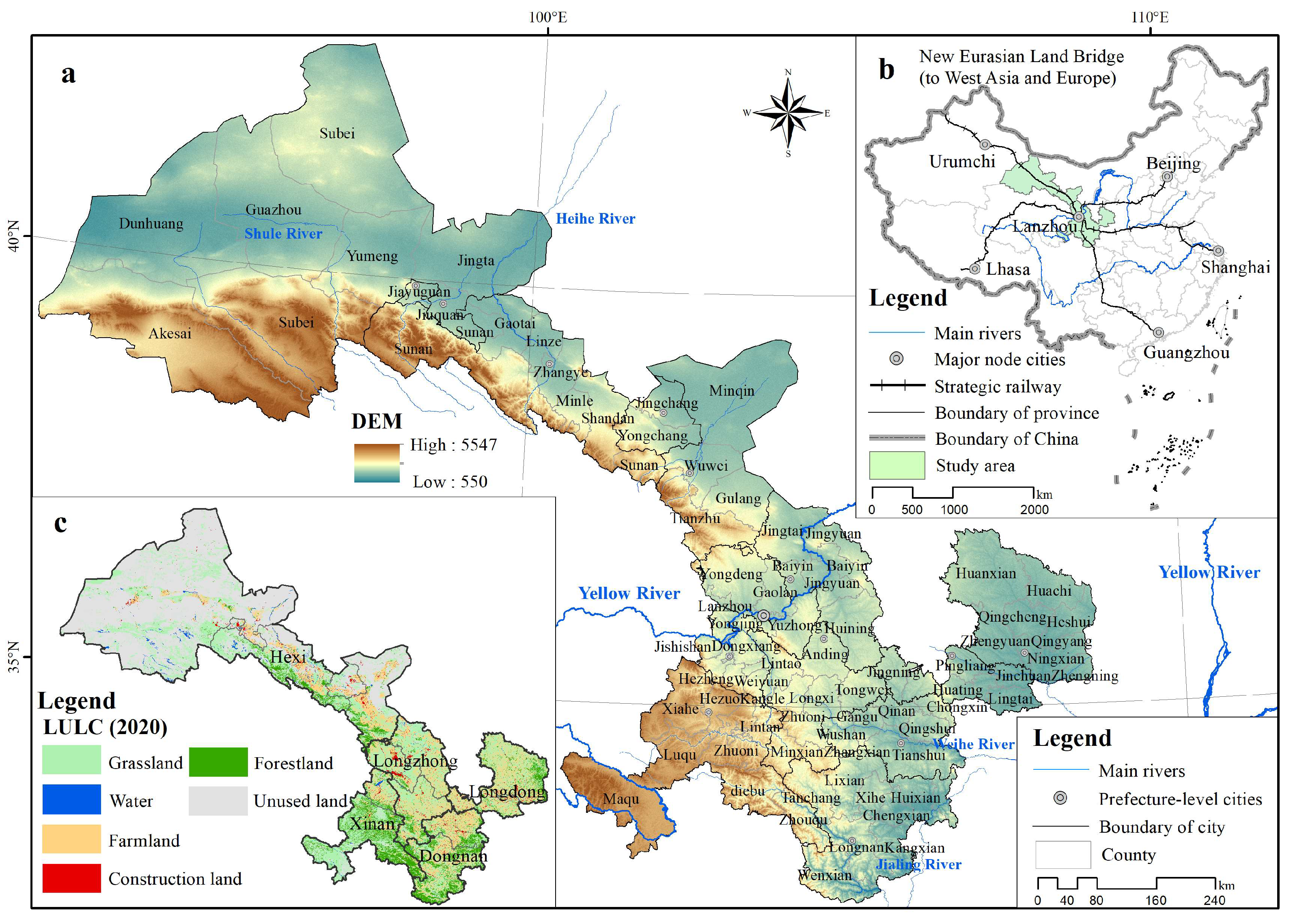
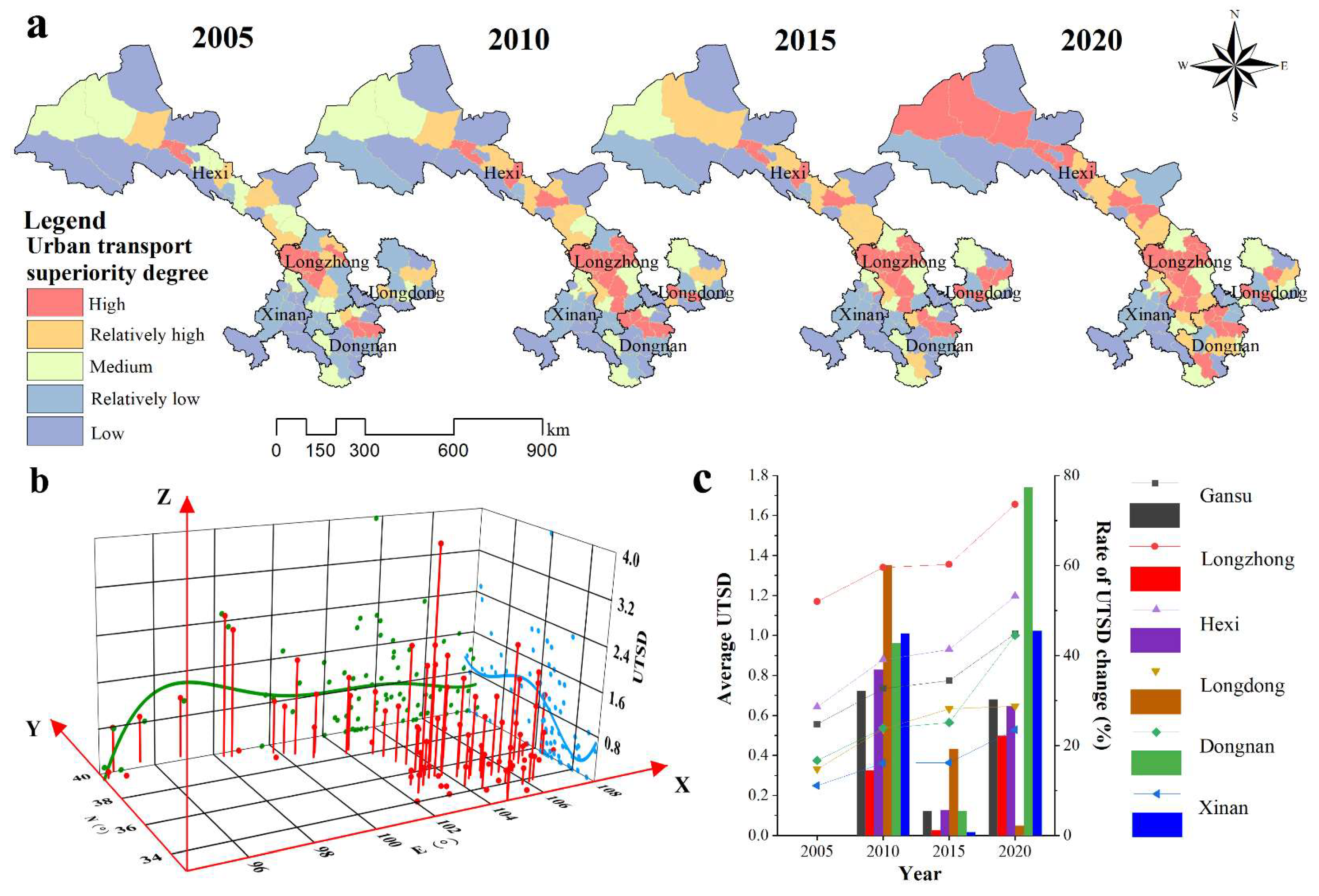

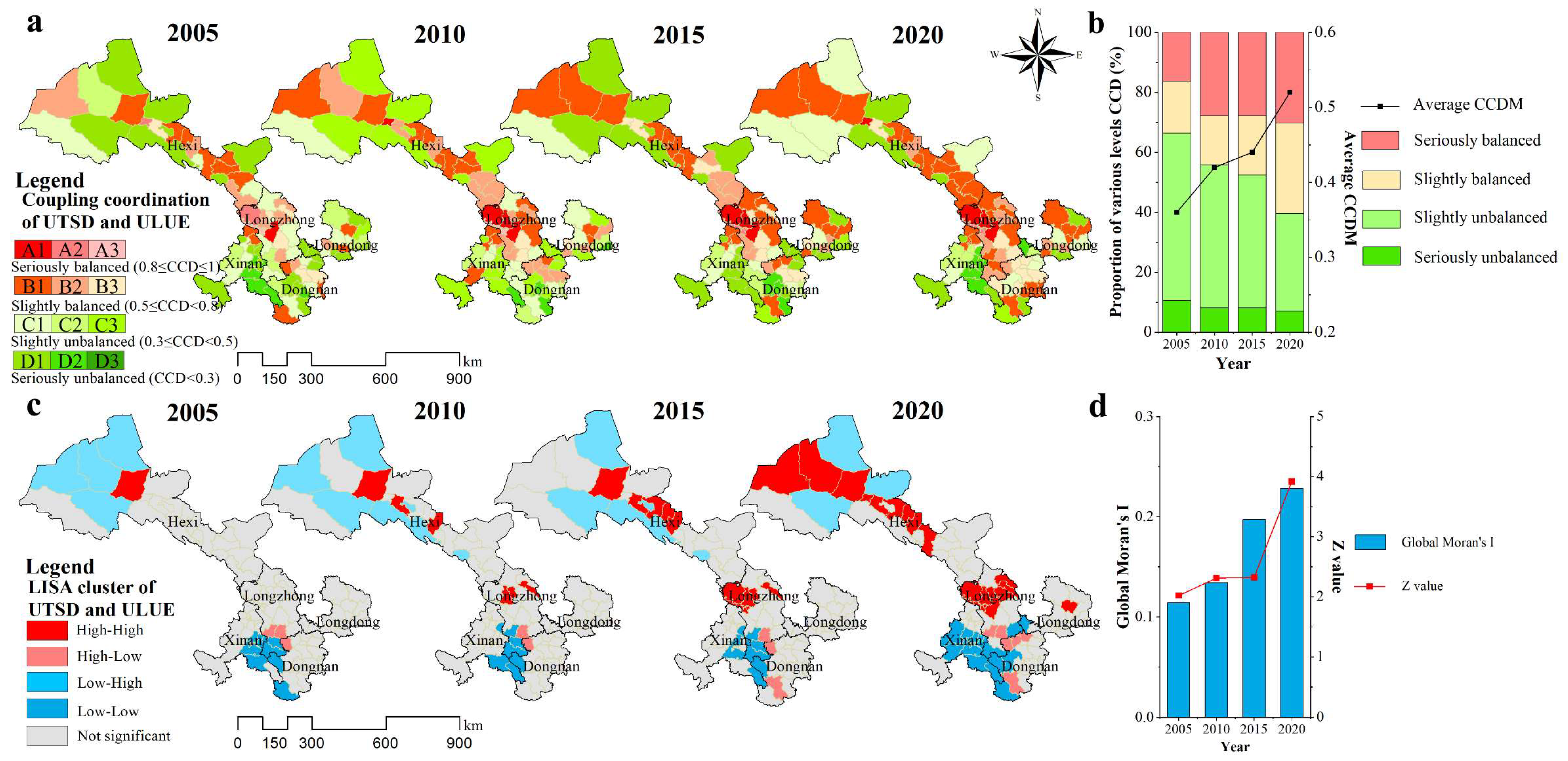
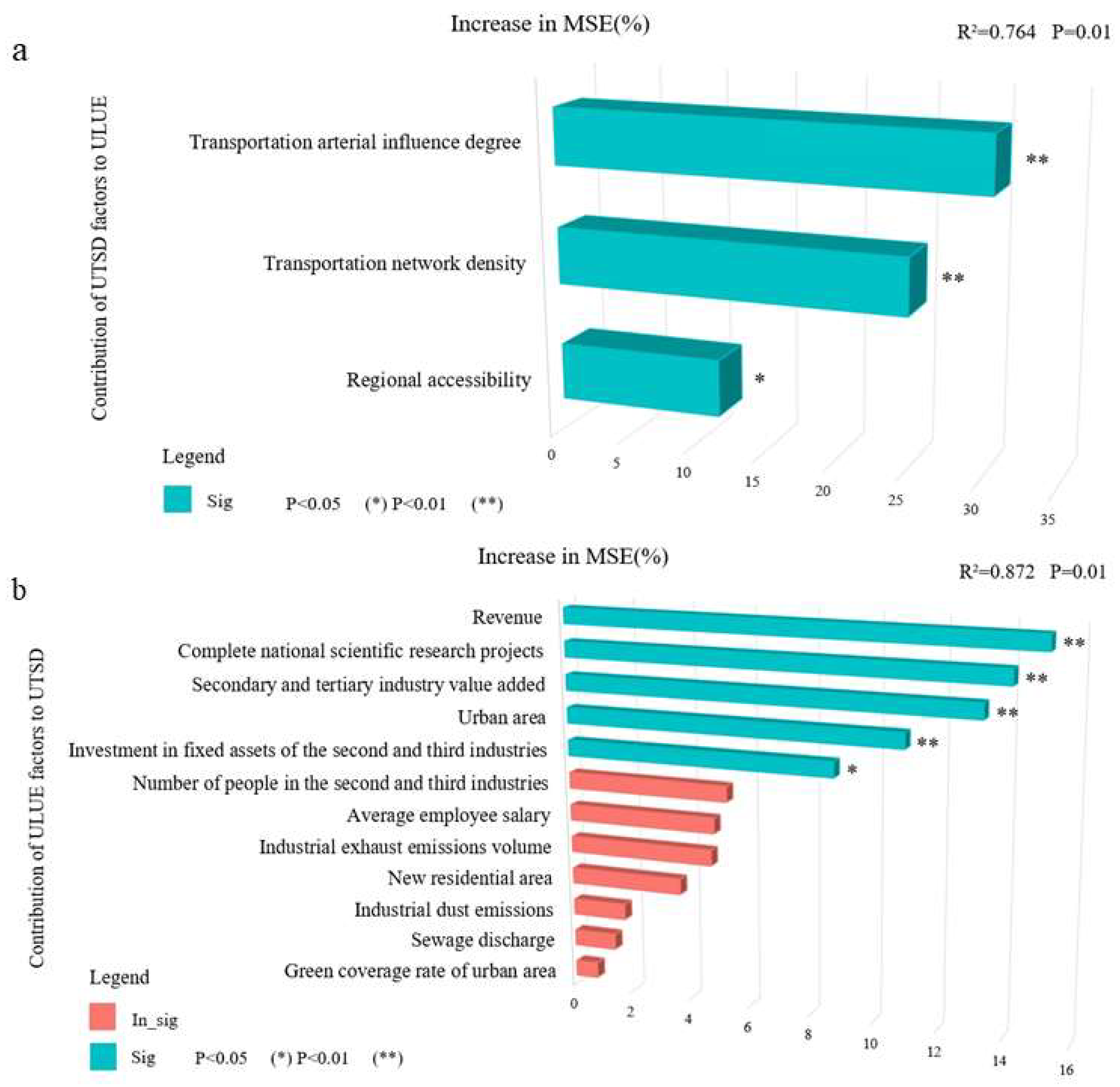
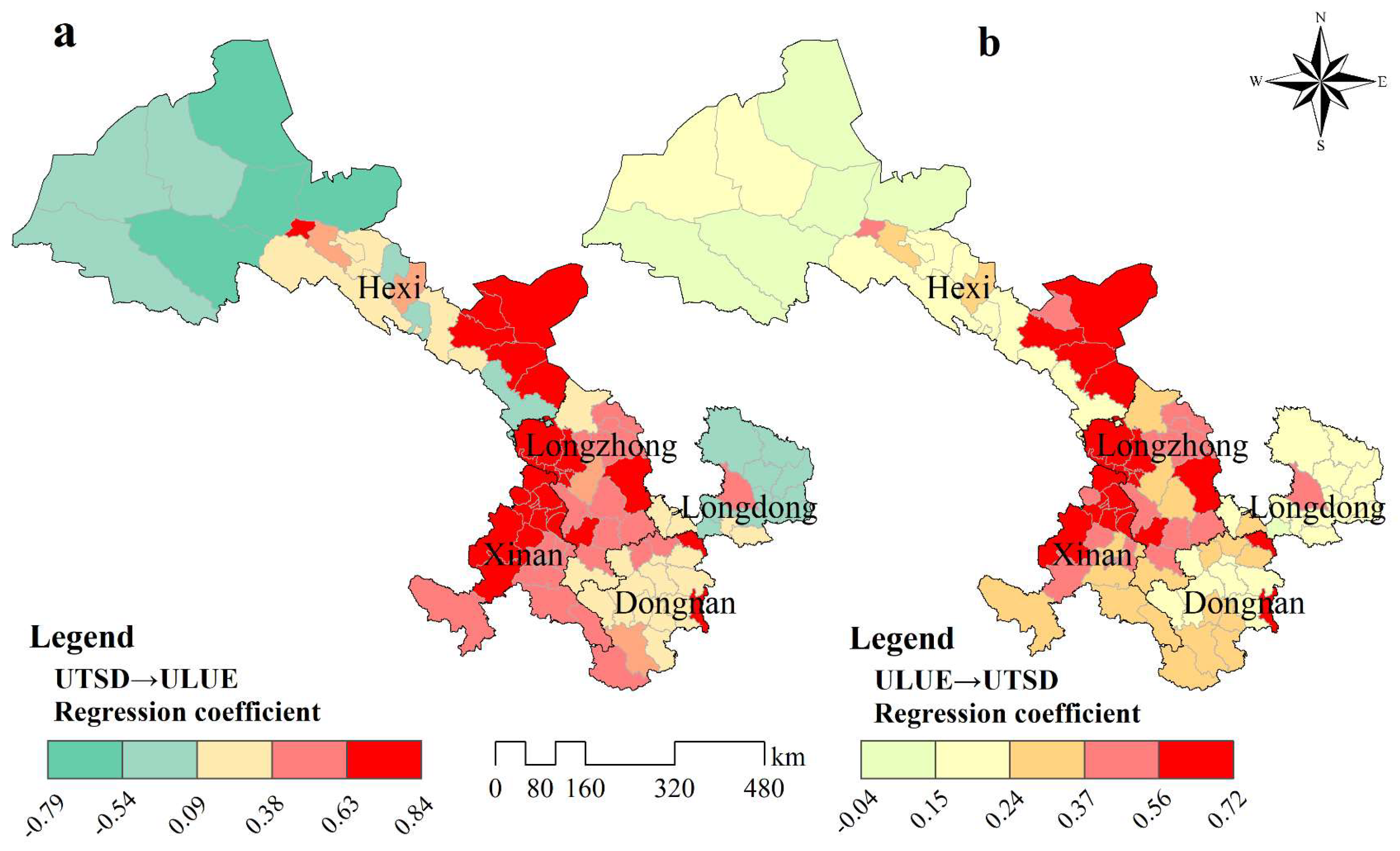
| Data Type | Data Name | Data Source | Description |
|---|---|---|---|
| Geographic environmental data | Residential point | Gansu Basic Geographic Information Center (https://www.webmap.cn/store.do?method=store&storeId=105; accessed on 10 March 2024) | Spatial latitude, longitude and elevation of settlements. |
| Administrative unit boundaries | Spatial location and area of each administrative region. | ||
| River system | Resource and Environment Science and Data Center (http://www.resdc.cn; accessed on 10 March 2024) | Spatial distribution of rivers. | |
| Elevation | Digital elevation model (DEM) raster data. | ||
| Transportation network data | Railway network | China Railway Corporation (http://wap.china-railway.com.cn; accessed on 15 March 2024) | Distribution of ordinary and high-speed railways in operation in Gansu, 2005, 2010, 2015 and 2020. |
| Highway network | National Platform for Common Geospatial Information Services (https://www.tianditu.gov.cn/; accessed on 15 March 2024) | Distribution of operational highways, national highways, provincial highways, county highway and township road in Gansu, 2005, 2010, 2015, and 2020. | |
| Airport | Civil Aviation Administration of China (www.caac.gov.cn; accessed on 20 March 2024) | Airports and air routes in operation in Gansu, 2005, 2010, 2015, and 2020. | |
| Traffic hub city | Ministry of Transport (www.mot.gov.cn; accessed on 20 March 2024) | According to the Ministry of Transportation, Lanzhou is the only comprehensive transportation hub and center city in Gansu. | |
| Socioeconomic data | Urban land | Resource and Environment Science and Data Center (http://www.resdc.cn; accessed on 10 March 2024) | LULC raster data were used to calculate the built-up area of each district and county in Gansu for the years 2005, 2010, 2015, and 2020. |
| Population density | Open Spatial Demographic Data and Research (https://www.worldpop.org; accessed on 10 March 2024) | Population density raster data for 2005, 2010, 2015, and 2020 were publicly available data. | |
| Economic production | Gansu Provincial Bureau of Statistics (https://tjj.gansu.gov.cn/; accessed on 10 March 2024) | Economic production data were collected from the Gansu Provincial Statistical Yearbook (2006–2021), specifically including input data, output data, and pollutant discharge data in production activities. |
| Criterion Layer | Indicator Layer | Significance | Quantitative Methods | Description | Weight | |
|---|---|---|---|---|---|---|
| Urban transport superiority degree (UTSD) | Quantity | Transportation network density | Transportation network density is the operational length of the network of transportation facilities per unit of land area and is a quantification of the size of the transportation network, reflecting the (short-distance) transportation capacity within each county unit [27]. | (1) | In Equation (1), is the transportation network density value of the study unit is the operational length of roadway facilities in the study unit , and is the land area of the study unit . | 0.281 |
| Quality | Transportation arterial influence degree | Arterial transport is primarily responsible for (long-distance) transport between county units, and the degree of impact of arterial transport reflects the connectivity between units within the larger region. Existing evaluation methods score arterial transportation facilities in terms of their distance to administrative centers. This ignores the actual distribution of population and the scoring method is inevitably subjective [7,50]. In this paper, the weighted average proximity of population raster data and traffic arteries is used to quantify the impact of traffic arteries. This reflects, to some extent, the coupled relationship between the infrastructure layout of traffic arteries and population distribution and helps to understand the impact of traffic arteries more objectively [48,51]. | . (2) | In Equation (2), represents the impact degree of trunk traffic in county area ; j includes 6 types of high-speed railway, ordinary railway, airport, highway, national road and provincial road; is the weight of class traffic facilities, which is taken as 1/6 in this paper. is the population number of population grid cell in county region is the nearest distance of population grid cell in county with respect to traffic facilities is the number of grids in county (for high-speed railway, ordinary railway, and airports, the closest distance to the station is used. For other modes, the closest distance to the entrance/exit is used). The closer the distance is, the smaller the value of the population-weighted average traffic proximity and the greater the potential of traffic facilities to produce benefits [20]. | 0.392 | |
| Situation | Regional accessibility | Regional accessibility is measured by the minimum travel time for each county unit to reach the provincial center city by all modes of land transportation. It reflects the extent to which the unit is radiated by the core city [38]. Land transportation modes are chosen for calculation because there are no navigable rivers in Gansu, air transportation is too costly and has a small capacity, and all types of land transportation are the most dominant modes of travel and transportation (Qin et al., 2022) [52]. | (3) (4) | In Equations (3) and (4), is the accessibility value of the study unit denotes the length of the road network of the road type in the study unit is the average travel speed on the road type is the average time cost for the road type in the study unit , and is the number of road types. The average speeds on high-speed railroads, railroads, highways, national highways, and provincial highways were set at 250, 120, 100, 80, and 60 km/h, respectively [53]. | 0.327 | |
| Pointer Type | Criterion Layer | Index Layer | Unit |
|---|---|---|---|
| Input index | Land investment | Construction land area | km2 |
| Labor input | Number of people in the second and third industries | 10,000 people | |
| Capital investment | Investment in fixed assets of the second and third industries | Million Yuan | |
| Energy input | Electricity consumption | Million kW h | |
| Water consumption | Million m3 | ||
| Desirable output | Economic output | Secondary and tertiary industry value added | Million Yuan |
| Tax revenue | Million Yuan | ||
| Average employee salary | Yuan | ||
| Social output | New residential area | 10,000 m2 | |
| Complete national scientific research projects | Number | ||
| Environmental output | Green coverage rate of building area | % | |
| Undesirable output | Environment Undesirable output | Sewage discharge | 10,000 Tons |
| Industrial exhaust emissions volume | 10,000 Tons | ||
| Industrial dust emissions | 10,000 Tons |
| Time-Series Data | ADF Statistics | p-Value | Threshold Value | ||
|---|---|---|---|---|---|
| 1% | 5% | 10% | |||
| UTSD | −8.7911 | 0.0000 | −3.4505 | −2.8703 | −2.5715 |
| ULUE | −7.8651 | 0.0000 | −3.4505 | −2.8703 | −2.5715 |
| Null Hypothesis | Lags | F-Statistics | Prob | Estimate |
|---|---|---|---|---|
| ULUE does not the Granger cause of UTSD | 1 | 3.4395 | 0.0333 | Rejection |
| UTSD does not the Granger cause of ULUE | 1 | 6.7018 | 0.0014 | Rejection |
| Influence Factors | VIF Value | Influence Factors | VIF Value | Influence Factors | VIF Value |
|---|---|---|---|---|---|
| Transportation network density | 4.79 | Electricity consumption | 15.19 | Complete national scientific research projects | 4.43 |
| Transportation arterial influence degree | 4.13 | Water consumption | 13.02 | Green coverage rate of urban area | 1.02 |
| Regional accessibility | 2.61 | Secondary and tertiary industry value added | 7.92 | Sewage discharge | 1.67 |
| Urban area | 2.58 | Tax revenue | 5.64 | Industrial exhaust emissions volume | 3.85 |
| Number of people in the second and third industries | 3.25 | Average employee salary | 1.23 | Industrial dust emissions | 2.26 |
| Investment in fixed assets of the second and third industries | 6.72 | New residential area | 2.38 |
| Independent Variable | Bandwidth | AICc | Sigma | Spatiotemporal Distance Ratio | R2 | R2 Adjusted | |
|---|---|---|---|---|---|---|---|
| UTSD | 0.0386 | 5.0854 | 0.1662 | 0.4831 | 0.9773 | 0.9769 | 0.0830 |
| ULUE | 0.1033 | 6.0334 | 0.2329 | 0.2687 | 0.8750 | 0.8744 | 0.1229 |
Disclaimer/Publisher’s Note: The statements, opinions and data contained in all publications are solely those of the individual author(s) and contributor(s) and not of MDPI and/or the editor(s). MDPI and/or the editor(s) disclaim responsibility for any injury to people or property resulting from any ideas, methods, instructions or products referred to in the content. |
© 2024 by the authors. Licensee MDPI, Basel, Switzerland. This article is an open access article distributed under the terms and conditions of the Creative Commons Attribution (CC BY) license (https://creativecommons.org/licenses/by/4.0/).
Share and Cite
Li, J.; Pan, N.; Ma, X.; Cheng, Z.; Yao, Y.; Li, G.; Yuan, J.; Xu, G. Mutual Causality Between Urban Transport Superiority Degree and Urban Land Use Efficiency: Insights from County Cities in Gansu Province Under the Belt and Road Initiative. Land 2024, 13, 1787. https://doi.org/10.3390/land13111787
Li J, Pan N, Ma X, Cheng Z, Yao Y, Li G, Yuan J, Xu G. Mutual Causality Between Urban Transport Superiority Degree and Urban Land Use Efficiency: Insights from County Cities in Gansu Province Under the Belt and Road Initiative. Land. 2024; 13(11):1787. https://doi.org/10.3390/land13111787
Chicago/Turabian StyleLi, Jie, Ninghui Pan, Xin Ma, Zhiyuan Cheng, Yao Yao, Guang Li, Jianyu Yuan, and Guorong Xu. 2024. "Mutual Causality Between Urban Transport Superiority Degree and Urban Land Use Efficiency: Insights from County Cities in Gansu Province Under the Belt and Road Initiative" Land 13, no. 11: 1787. https://doi.org/10.3390/land13111787
APA StyleLi, J., Pan, N., Ma, X., Cheng, Z., Yao, Y., Li, G., Yuan, J., & Xu, G. (2024). Mutual Causality Between Urban Transport Superiority Degree and Urban Land Use Efficiency: Insights from County Cities in Gansu Province Under the Belt and Road Initiative. Land, 13(11), 1787. https://doi.org/10.3390/land13111787






